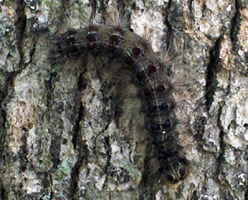AGRICULTURE DEPARTMENT BATTLING HEAVY GYPSY MOTH INFESTATION
Secretary Kuperus Warns of Increased Defoliation This Year
For Immediate Release: May 10, 2007Contact: Jeff Beach
(609) 292-5531
(TRENTON) – New Jersey residents in 11 counties are expected to see increased tree defoliation from gypsy moth caterpillars this year, New Jersey Agriculture Secretary Charles M. Kuperus said today.
“We are making every effort to combat the severe defoliation caused by the gypsy moth over the past several years,” Secretary Kuperus said. “We fully appreciate how damaging these insects are and how much of a nuisance their droppings can create. Residents should know that we are using the best science available to us to address this problem.”
The hardest hit areas will be in portions of Atlantic, Burlington, Ocean, Monmouth, Warren and Sussex counties, Secretary Kuperus said. Statewide, the Department expects more than 200,000 acres of forested and residential areas to be defoliated by the voracious caterpillars, whose population was expected to at least equal, and most likely surpass, that of last year when 125,743 acres were defoliated statewide.
The caterpillars primarily attack oak trees, stripping their leaves, but they also can harm conifers. Oaks can die after three straight years of severe defoliation and conifers can die after just one season of such activity. With several straight years of severe defoliation occurring in New Jersey, tree mortality is expected to increase.
“The gypsy moth is an increasingly serious problem in New Jersey, and we are making every effort to help our municipalities suppress the damaging levels of defoliation,” Secretary Kuperus said.
The Department employs Integrated Pest Management techniques in its gypsy moth suppression efforts, targeting 62,500 acres for aerial spraying of the insecticide Bacillus thuringiensis var kurstaki, or B.T.K., the least toxic spray material for this purpose. In addition, the Department encourages the activity of fungus disease and other natural predators of the caterpillar. Over the past several years, natural conditions that have not been conducive to the predators have resulted in the need for increased spraying to try to control the gypsy moth population.
In response, the Department has stepped up its aerial spraying effort, including back-to-back treatments of B.T.K. on 25,252 acres in 2006. The Department also cooperates with the Department of Environmental Protection’s NJ Forest Service, which plans to treat 3,750 acres of state properties in Burlington and Sussex counties this year.
This year, the Department will receive nearly $1.5 million in federal funds for a 50-percent reimbursement to municipalities that participate in the voluntary aerial spraying suppression efforts. A chart listing this year’s spray zones, and the gypsy moth contact for each municipality, can be found at www.state.nj.us/agriculture/divisions/pi/prog/gmwebtable.html. As spray dates are announced, they will be posted on that chart. Additional information about gypsy moths can be found at www.state.nj.us/agriculture/divisions/pi/prog/gypsymoth.html.



